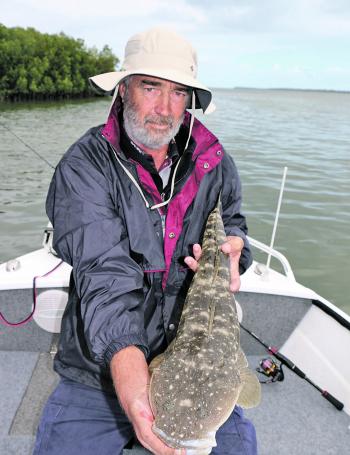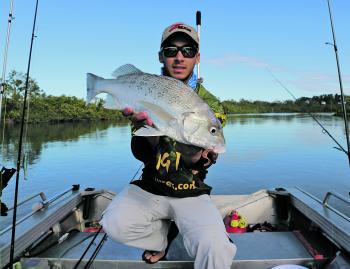We currently find ourselves in a transition period with the change of seasons. Due to our location, Hervey Bay is one of the only destinations that experiences a distinct overlap of both summer and winter species.
With more consistent southeasterly and southwesterly winds starting to blow, our water temperatures have started to drop quite dramatically to around 20-21°C. This has brought on the transition of species with snapper, grunter, mulloway, flathead, school mackerel and bream making their way into the bay.
The word from the beaches is that whiting have been a little hard to come by. However, fishing around the high tide coinciding with the full moon period will see greatest results if you’re chasing a feed. Baits such as yabbies, prawns and sand worms will work a treat fished on a light running ball sinker rig.
Good numbers of flathead have been taken from the gutters along the beach front and off the Urangan Pier in the first and second channel. Fresh or live hardyheads and herring work best for the flatties and for the lure addicts a 3-4” paddle or curl-tail will be very effective.
School mackerel have turned up in very large numbers and have been taken on both Flasha metal spoons and/or live herring fished on the bottom and free swimming. Make sure you know the correct size limits, as there have been a lot of smaller fish caught. Bream are also currently a target species off the Urangan Pier and their numbers will only continue to grow thicker as water temperatures drop.
Fresh cubes of herring or a crab imitation lure fished tight to the pylons have proved effective and fishing for them at night usually produces the bigger fish. While fishing the night time periods, mulloway are currently appearing in good numbers, hiding in the shadows of the down lights and readily taking an unweighted live herring or pike.
The inshore and artificial reefs have started to produce snapper to 60cm and are taking well-presented soft plastics and slow trolled hardbodies. A few proven lures to try are the ZMan 5” StreakZ Curly Tailz fished as lightly as the conditions will permit. Allow your presentation to slowly waft down the water column. Hardbodies that can get down to around 7-8m have been incredibly successful on the snapper.
This slow trolling technique is a very effective way for covering ground or when searching for fish. Fresh bait will also produce good results with the ever-faithful pilchard, pencil squid and mullet strips being great options. The best results have occurred when the high tide coincides with either dawn or dusk, when the wrecks have a greater amount of water over them. While fishing these areas and using these techniques, cod, coral trout and sweetlip are still being caught, but their numbers have declined.
School mackerel numbers are in plague proportions with good numbers of quality fish being taken from the inshore beacons and the Burrum Eight-Mile and Six-Mile areas. Spinning with spoons is a very effective technique with the 35g and 50g Flasha spoons working best.
Whole pilchards and live herring are working well with anglers catching quality fish on these baits. Vary your spread with a few baits down on the bottom and a few free swimming or under a biodegradable balloon, as this allows you to cover the whole water column. This technique during the night will also produce numbers of juvenile snapper and grunter.
The flats and adjacent creek mouths on the western side of Fraser Island are a great option at this time of year and can make for some awesome sight fishing to bream and flathead in the gin clear waters. These areas are very tidal and you can find yourself trapped on the flats or up a creek for a very long time if you’re not keeping an eye on the tide.
Roughly two hours either side of the high tide is a good safety measure when fishing in these areas. Fishing with soft plastics is a very effective technique and allows you to cover a large area of water quickly. For the avid lure and fly sportfishers good numbers of mixed trevally species and queenfish are still being sight fished and caught.
Down the Straits the main attraction at the moment is the large number of quality grunter being caught. Deeper holes and gravel banks are producing the best catches. The run-out tide is always a good time to target grunter as they recede from among the vast flats systems amongst the mangroves and congregate in open waters in good numbers. This makes them quite an easy target for lure anglers.
Fishing these same areas is also producing good numbers of flathead and bream. Heading up the Island there are still reports of tuna hanging around, however the longtail tuna numbers have decreased dramatically making them a little harder to locate and target. The fish that are still hanging around are of a very good size, nudging 15-20kg.
Golden trevally are in abundance over the rubble patches and artificial reefs, with most fish falling to soft plastics and micro-jigs. Juvenile snapper are also appearing in these same areas with the bigger fish not too far away now. They will be well worth targeting in the lead up to the full moon.
It is well worth the time and effort to take a few pots and set them for sand crabs while you spend the day fishing, as anglers are being rewarded with some good quality crabs. Allow a good length of rope for the depth and weighting the pot down with a brick or short length of chain will help to hold them in place.
Due to the weather there have been limited opportunities for anglers to venture across the Breaksea spit. Anglers that have braved the conditions or caught a good day have been rewarded. Topwater enthusiasts have been catching large GTs and Spanish mackerel over the shallow reef areas and the wider wrecks have been a jig fisher’s playground. Be prepared to donate some jigs to the unstoppable brutes.
As water temperatures drop and the fish migrate deeper and the large bait balls start to congregate and stack up along the shelf, this will make for some incredible fishing, either deep dropping for snapper and pearlies or jigging for big amberjack, green jobfish and kingfish.
The southern and northern gutters systems are continuing to fire with large numbers of coral trout being caught on either live pike or soft plastics. Targeting the face of the ledge country around the 30-40m mark has seen greatest results.
In these same areas cod, tuskfish, Spanish flag, nannygai and juvenile red emperor have all been caught on fresh cut baits. There are still good numbers of pelagics out this way as well. Tuna and numerous species of mackerel and trevally are hanging around the bait balls often found up on the flat country.
As we move into yet another season with our water temperatures starting to drop, we will experience some very exciting fishing here on the Fraser Coast. If weather permits then the wider reefs are going to fire for a host of different species, so buckle in.
Reads: 2598
The author with a pocket-rocket-size golden trevally taken off an inshore wreck, that was tempted with a ZMan 3” MinnowZ in green lantern while searching for a snapper.

Fishermans Corner regular Paul Mares with a quality lizard taken from one of the creek mouths on the western side of Fraser on a recent trip with the author.

The author had a cracking session on the grunter with curl-tail soft plastics being the go-to lure presentation.




